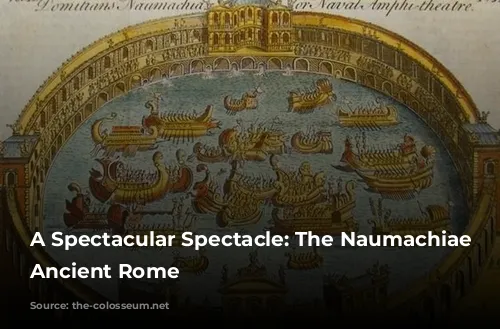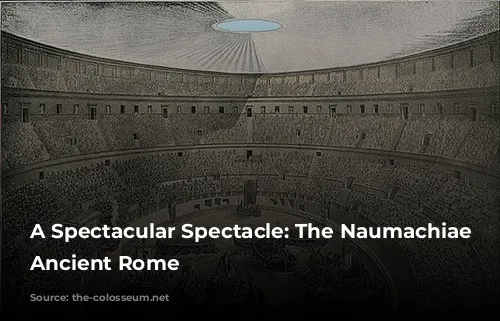Naumachiae were more than just shows; they were grand, theatrical re-enactments of famous naval battles, a spectacle that captivated the hearts of ancient Romans. These lavish displays of power and skill were staged in massive basins specifically designed to be flooded, allowing for the dramatic clash of ships and sailors.
A Theater of Death
Imagine the scene: A vast basin, shimmering with water, its surface a stage for a maritime battle of epic proportions. Ships, meticulously crafted and adorned with intricate details, maneuvered with precision, mimicking the movements of real warships.
The actors in these spectacles, sadly, were often criminals sentenced to death. Their lives were a price paid for the entertainment of the masses. These performances were not merely entertaining; they were a chilling reminder of the Roman justice system’s harshness.
A Colossal Production
These naumachiae were the equivalent of modern-day blockbusters, extravagant displays of wealth and technical prowess. The Romans called them navālia proelia (naval battles), but the term naumachia evolved to encompass both the performance and the basin itself.
These naval re-enactments often recreated famous historical battles, like the Greek triumph at Salamis or the Corcyreans’ destruction of the Corinthian fleet. The scale of these performances was awe-inspiring. In one naumachia, a fortress was built in the center of the basin, allowing “Athenian” forces to land and attack a “Syracusan” stronghold. The battles were meticulously recreated, thrilling the audience with their realism and the skill of the performers.
A Legacy of Naumachiae
While Martial, a Roman poet, tells us that naumachiae were performed in the Colosseum in its early years, modern archaeologists believe they were later abandoned. The immense effort required to flood the arena, making it watertight to a depth of 1.5 meters to accommodate ships, proved too daunting. This leads to speculation that the Colosseum’s underground was excavated only after its inauguration, under Emperor Domitian.
The first naumachia was commissioned by Julius Caesar to celebrate his triumph in Egypt. It was held in Rome, in a temporary basin excavated in the Campus Martis, and recreated a battle between Egyptians and Phoenicians. Augustus, Caesar’s successor, continued the tradition, organizing more naval battles in the Septa, a monumental complex in Rome.
Augustus, whose power rested upon his naval victory at Actium, likely saw these naumachiae as a celebration of Rome’s maritime strength. He had a special basin constructed for these shows, measuring an impressive 598 by 393 yards. An aqueduct, stretching 22,000 paces, was built to transport water from a nearby lake to fill the basin. The inaugural naumachia involved 30 ships and 3,000 participants, a spectacle that continued to amaze audiences under Emperors Nero and Titus.
A Monumental Engineering Feat
Emperor Claudius, in 52 AD, took the naumachia to another level of grandeur. He staged a naval battle on the Fucine Lake in central Italy, using the occasion to celebrate the completion of a remarkable engineering feat – a drainage tunnel that diverted the lake’s water into a nearby valley.
This tunnel, a feat of Roman ingenuity, took eleven years to complete, requiring the labor of 30,000 workers operating in three shifts around the clock. The result was a 5.6 km long tunnel under Mount Salviano, capable of partially draining the Fucine Lake into the Liri river. To commemorate this achievement, Claudius organized a naumachia, featuring a battle between the Rhodians and the Sicilians.
The spectacle was staged on a grand scale, with rafts carrying Praetorian guards positioned around the lake to prevent the escape of the 19,000 condemned prisoners who were used as participants. The lake’s shores were packed with spectators, eager to witness the thrilling naval battle.
A Legacy of Naumachiae
The naumachia were more than just entertainment; they were a powerful symbol of Roman power and ingenuity. These magnificent displays combined spectacle, engineering, and military might, leaving an enduring legacy on the imagination of the ancient world. While the Roman Empire may have long since fallen, the echoes of these grand naval battles continue to resonate throughout history, reminding us of the Romans’ ability to transform the ordinary into the extraordinary.

